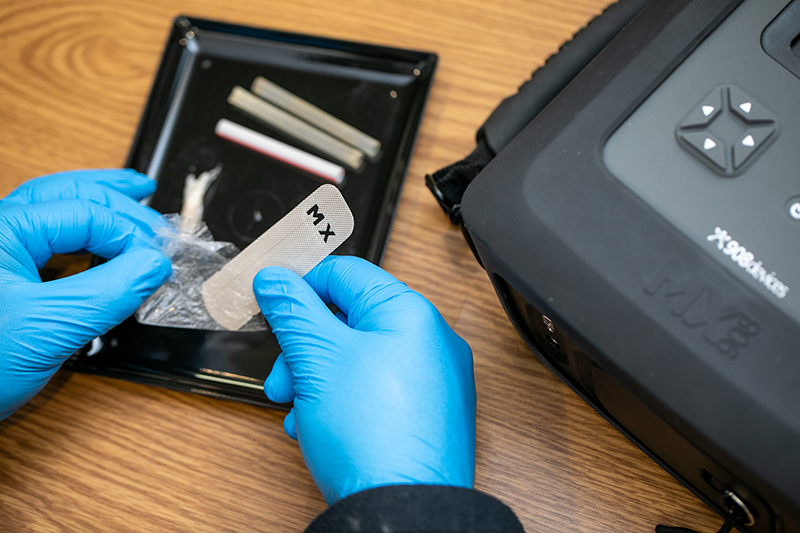Emerging Drug Trends and Threats
According to the Centers for Disease Control and Prevention, rates of overdose deaths involving synthetic opioids increased over 22% from 2020 to 2021. What’s more, research related to drug trends published in JAMA Network found in 2021, fentanyl was identified in 77% of adolescent overdose deaths, compared with 13% for benzodiazepines, 10% for methamphetamine, 7% for cocaine, 6% for prescription opioids, and 2% for heroin.
It is imperative to stay ahead of these dangerous drug trends and emerging threats – but how? One way is to track spikes of different substances in the field. We regularly partner with and analyze The Center for Forensic Science Research & Education’s (CFSRE) quarterly trend reports, which provide near real-time information regarding new psychoactive substance (NPS) prevalence, positivity and turnover. New threats are regularly evaluated for inclusion in our MX908 device target list so law enforcement and other users of our in-field device are well equipped with current emerging threats and have a comprehensive analysis of a wide range of substances to help inform mitigation, remediation and community outreach efforts; all of which are critical for preparedness in unknown scenarios and faster response time.
Drugs On Our Radar
It’s no surprise one of the biggest ongoing drug trends and threats we’ve tracked for years is fentanyl. Currently our MX908 can identify and detect over 2,000 fentanyl analogs and counting. There’s also challenges and nuances when fentanyl is mixed with other dangerous drugs, like xylazine (also known as Tranq, an animal tranquilizer), and even counterfeit pharmaceuticals.
Beyond the obvious, two drugs we have our eye on include captagon and dipentylone. While captagon captured headlines recently (including Bloomberg, POLITICO and Reuters) dipentylone is the next drug we’re seeing concerning spikes around. To those not familiar, it’s a substituted cathinone derivative with stimulant effects similar to amphetamines and is solid in powder and tablet forms on the street as ecstacy or molly. While first identified in the U.S. during the fall of 2021, in recent months we’ve seen increased identification and detection through our customers and the CFSRE.
What Can You Do Related to Emerging Drug Trends and Threats?
Staying abreast of emerging drug trends and threats, especially substances like fentanyl, xylazine, captagon and dipentylone, requires a multifaceted approach. Here are three strategies for law enforcement personnel to stay informed:
- Training and Education – Continuous training on emerging drug trends and threats should cover the latest trends in drug abuse, including the emergence of synthetic drugs and modifications to existing substances.
- Health Surveillance Programs – Implement health surveillance programs to monitor trends in drug-related illnesses and overdoses and collaborate with public health agencies to collect and analyze data on drug-related incidents.
- Community Engagement – Engage with trusted local groups to act on intelligence and foster more awareness and connect individuals to resources, including addiction treatment.
By combining these strategies with the use of advanced technologies, law enforcement agencies can create a more comprehensive and effective approach to staying ahead of emerging drug threats and protecting communities.
Forging a Path Forward
With more than 100,000 overdoses in 2023 and rising, we’re in the midst of a national crisis. It is imperative that law enforcement personnel tasked with monitoring and responding to emerging drug threats are equipped with technology to ensure they stay abreast of trends and ensure their own safety in dealing with dangerous substances. Having a field-portable device, such as MX908, to aid in the rapid identification of drugs and hazardous materials, is an essential part of any surveillance strategy.
The ability to respond quickly to unknown substances and a shifting landscape will be key to staying ahead or in control of new waves of rapidly emerging, dangerous drug threats. Not to mention, with recent instances of fentanyl-laced letters being sent to election offices, the coming months leading up to the U.S. presidential election will undoubtedly present new threats. Whatever the challenge, preparation and awareness of what’s ahead starts now.
Drug Identification Solution
MX908 is a portable mass spectrometer that is used by emergency responders. These responders are involved in various operations such as dealing with chemicals, explosives, drugs, and hazardous materials. This device has the ability to detect small amounts of compounds and has an exceptional level of sensitivity and selectivity. It provides valuable and detailed drug identification information. The high-pressure mass spectrometry (HPMS) technology effectively distinguishes between actual threats and other substances that often trigger false alarms when using other technology methods.
